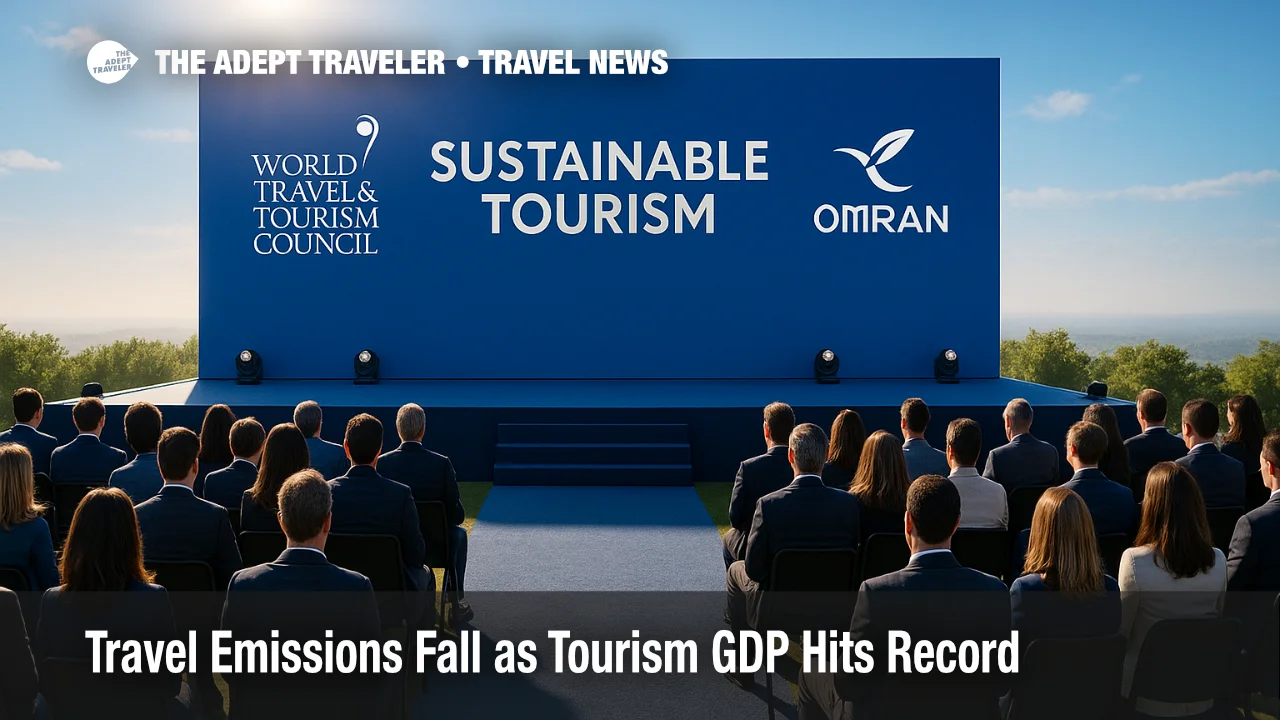WTTC ESR 2025: Emissions fall as tourism GDP hits record

Travel & Tourism is growing cleaner and stronger at the same time, according to WTTC ESR 2025. The council's latest Environmental & Social Research, produced with Omran, finds the sector's 2024 greenhouse-gas share down to 7.3 percent from 8.3 percent in 2019 even as its GDP footprint rose to $10.9 trillion, up 6 percent from the pre-pandemic peak. WTTC credits lower emissions intensity, wider use of low-carbon energy, and efficiency improvements across supply chains and transport.
Key points
- Why it matters: Travel demand is surging, but WTTC ESR 2025 shows emissions intensity is falling.
- Travel impact: Cleaner energy and efficiency gains are decoupling growth from emissions.
- What's next: Public-private moves on sustainable fuels, renewables, and grid access.
- Women in Travel & Tourism reached 126 million in 2024, with youth share at 15.7 percent.
- Governments collected $3.5 trillion in tax revenues from the sector in 2024.
Snapshot
WTTC ESR 2025 reports a 9.3 percent decline in sector GHGs since 2019, even as 2024 output reached $10.9 trillion. Emissions intensity is down 15 percent, driven by a 16.6 percent increase in low-carbon energy adoption and a 5.7 percent cut in fossil-fuel use. Transport remains the biggest lever, responsible for 40 percent of emissions, followed by purchased electricity at 19 percent. Supply chains account for 57.4 percent. On the social side, Travel & Tourism supported one in ten jobs worldwide, including 126 million women, and lifted youth representation to 15.7 percent compared with 13.7 percent economy-wide. Governments collected $3.5 trillion in taxes, a 6.1 percent gain over 2019.
Background
WTTC's ESR program measures environmental footprints alongside social outcomes across 185 economies. The 2025 edition highlights a sector that surpassed its pre-pandemic economic peak while shrinking its relative climate impact. Efficiency improvements span aircraft, cruise, accommodations, and destination infrastructure, with growing access to renewable electricity and early adoption of lower-carbon fuels. The data comes as destinations and operators pilot decarbonization pathways, from climate-neutral coastal voyages to port electrification and hotel energy retrofits. Policymakers are under pressure to calibrate new levies carefully, reinvesting proceeds into local infrastructure, workforce development, and low-carbon upgrades that sustain competitiveness and community benefits.
Latest developments
WTTC ESR 2025 puts numbers behind decoupling growth from emissions
WTTC says sector emissions in 2024 fell 9.3 percent from 2019 while GDP rose to $10.9 trillion. Emissions intensity dropped 15 percent, aided by a 16.6 percent rise in low-carbon energy and a 5.7 percent decline in fossil-fuel use. Transport drives 40 percent of emissions, and 19 percent comes from electricity purchases; 57.4 percent lies in the supply chain. Social indicators strengthened as well, with 126 million female workers and youth employment exceeding pre-pandemic levels by 2.4 million. Tax take reached $3.5 trillion, about one-tenth of global government revenues.
Where the transition is happening on the ground
Operators and destinations are piloting climate solutions that align with ESR findings. On the maritime side, a climate-neutral coastal voyage plan in Norway showcases biogas and large-scale batteries, pointing to near-term reductions while zero-emissions tech matures. Policy experiments, like proposed caps tied to cleaner port calls, illustrate how incentives and standards can steer investment toward lower-carbon operations without throttling traveler access. For travelers, these shifts often show up as quieter port approaches, shore-power connections, and a growing set of small-group, low-impact experiences. See our related coverage: Havila Voyages climate neutral fleet targets zero emissions, Hawaii cruise reduction plan would slash ship calls 50 %.
Analysis
The ESR 2025 data signals a real, not rhetorical, bend in the curve: more value with less carbon per dollar. The near-term decoupling is primarily efficiency-led, not yet fuel-switch-led, which means continued progress depends on three accelerants. First, scale sustainable aviation fuel and low-carbon marine fuels through clear, bankable demand signals, long-dated offtakes, and harmonized standards so suppliers can invest. Second, expand renewable electricity access for hotels, attractions, airports, and ports, including reliable grid interconnects and resilient microgrids in tourism-heavy regions. Third, squeeze the supply-chain majority by shifting procurement to lower-carbon materials, food systems, and construction, with transparent data that links buyer choices to emissions outcomes.
Social metrics matter here. With 126 million women and an elevated youth share, the sector can channel workforce programs toward jobs created by the energy transition, from heat-pump retrofits to shore-power operations. Tax receipts of $3.5 trillion strengthen WTTC's case against blunt, tourism-specific levies that are not ring-fenced for infrastructure or community benefits. Smart policy will favor carrots over sticks, rewarding measurable emissions cuts, verified renewable usage, and equitable job creation. If fuel availability, grid capacity, and supply-chain transparency improve in parallel, ESR's decoupling trend can extend through the next demand cycle.
Final thoughts
WTTC ESR 2025 frames a sector at an inflection point: record economic output with a smaller share of global emissions. The path forward is pragmatic, pairing efficiency with faster deployment of sustainable fuels and renewable power while directing procurement toward lower-carbon suppliers. Travelers will feel the shift in quieter ports, greener stays, and better data on trip footprints. With targeted public-private partnerships, the gains in women's and youth employment can deepen alongside measurable climate progress. That is the core promise of WTTC ESR 2025.
